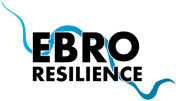The project

With the contribution of the LIFE financial instrument of the European Community
LIFE20 ENV/ES/000327
The LIFE Ebro Resilience P1 Project is a innovative proposal to deal with the phenomenon of flooding in the middle stretch of the Ebro, with a clear objective for the future: that the population and economic activities coexist with an Ebro in a good state of conservation without the inevitable floods causing significant damage..


Basic data
The LIFE Ebro Resilience P1 project (LIFE20 ENV/ES/00327) was selected by the European Commission under the LIFE 2020 call.
Its scope of action covers three autonomous communities (La Rioja, Navarra and Aragón), has a duration of 6 years and a total budget of 13,310,350 €, with 55% European funding.
The LIFE intervention period is 2021-2027.
The 5 keys to the project are:

The change in flood management, establishing a new fluvial model based on ADAPTATION to flooding and CONSERVATION of fluvial ecosystems.


The involvement of the population as a transversal axis of the actions and an inseparable part of flood management, seeking to achieve more solid results, improve knowledge and reach more sustainable alternatives, environmentally, socially and economically.


Administrative coordination and institutional cooperation The partners are the Ministry for Ecological Transition and Demographic Challenge (MITECO), through the company TRAGSA and its subsidiary TRAGSATEC; the Ebro Hydrographic Confederation; the Government of La Rioja; the Government of Navarra, through Gestión Ambiental de Navarra, SA (GAN-NIK), the Government of Aragon and the Aragonese Water Institute.

A firm commitment to technology for the design of adaptation and mitigation actions (highly accurate digital terrain models; state-of-the-art two-dimensional hydraulic modeling; simulations of extreme events, etc.).


Replication of the solutions proposed for similar cases in other rivers of the Ebro basin and other Spanish and European basins. This circumstance has been of special interest to the Commission and was essential for obtaining the funding.


A little context
Floods are unavoidable extreme phenomena, being the extreme event that causes most economic damage in Spain and Europe. Any action aimed at reducing its negative effects must be based on adaptation and risk reduction, understood as the avoidance of exposure (personal and material) to flooding.
The middle stretch of the Ebro is an area classified as having a high probability of flooding and is declared, for the most part, as an area of significant high risk. This means that floods are frequent and, in addition, cause considerable damage.
Since the middle of the 20th century, floods have been managed under the vision of total protection and control of the river, through the execution of important civil works: periodic dredging, defense dikes, channeling, walls, breakwaters, elimination of vegetation, etc., and not considering the environmental and ecological aspects of the riverbed. This type of management has not achieved the desired objectives, requires high conservation costs and, in most cases, has led to an increase in flood damage.
As an example, after the episode of extraordinary floods in the middle reaches of the Ebro during the first four months of the year. 2015, between emergency actions for the repair of the channeling of the Ebro Hydrographic Confederation and aid from the Autonomous Communities, the following investments were made 54.6 million in La Rioja, Navarra and Aragón.
At the beginning of the 21st century, there was a change in the approach to flood risk management that led to the Ebro Resilience Strategy and the LIFE Ebro Resilience P1 Project, whose approaches are based on adaptation to flooding and the protection of river ecosystems.
Where we will act
Ebro River as it passes through Alfaro (La Rioja) and Castejón (Navarra): we intend to demonstrate that measures to recover river space reduce the risk of flooding.
To this end, we will eliminate and/or build defense dikes further away from the riverbed on three meanders of the river. In this way we will be able to restore the fluvial use of these meanders, which will be environmentally restored.
The morphological adaptation actions will be carried out by TRAGSA under the direction of the Ebro Hydrographic Confederation (CHE) and the environmental restorations by the Autonomous Governments of La Rioja and Navarra, the latter through GAN-NIK.
Ebro River as it passes through Osera de Ebro and Fuentes de Ebro (Zaragoza): a novel intervention is proposed to make an intensively cultivated agricultural area compatible with the passage of floods.
For this purpose, the creation of lateral flow buffer zones has been planned. These buffer zones will compartmentalize farms into areas that will be pre-flooded just before the levees overflow, creating water buffers that will minimize damage to farms and infrastructure.
In addition, the capacity of the riverbed will be increased by recovering fluvial space through the recessing of two sections of the defense dike. These new river areas will be environmentally restored.
The works for the implementation of the lateral flow buffer zones and the recovery of fluvial space will be undertaken by TRAGSA under the direction of the CHE. The Government of Aragon will carry out the adaptation of the irrigation system and environmental restoration.

Where did the LIFE Ebro Resilience P1 Project come from?
This project is the result of the union of the European Union’s LIFE program and the Ebro Resilience Strategy.
The Strategy seeks a change in flood management and proposes a combination of innovative measures in 18 sections of the middle Ebro, from Logroño, in La Rioja, to La Zaida, in the province of Zaragoza.
The European Commission’s LIFE program seeks to prevent the loss of habitats and wildlife species, support the transition to a circular economy and protect natural resources.
